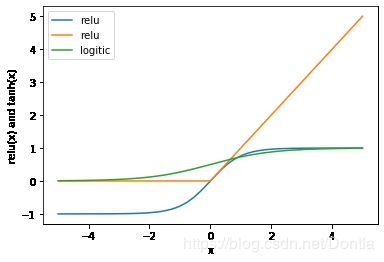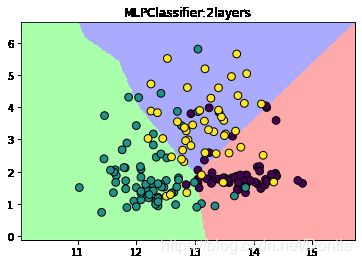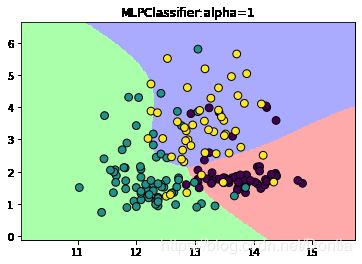import numpy as np
import matplotlib.pyplot as plt
line=np.linspace(-5,5,200)
plt.plot(line,np.tanh(line),label='relu')
plt.plot(line,np.maximum(line,0),label='relu')
plt.plot(line,1/(1+np.exp(-line)),label='logitic')
plt.legend(loc='best')
plt.xlabel('x')
plt.ylabel('relu(x) and tanh(x)')
plt.show()

from sklearn.neural_network import MLPClassifier
from sklearn.datasets import load_wine
from sklearn.model_selection import train_test_split
wine=load_wine()
print('打印wine:\n',wine,'\n')
print('打印wine.data.shape',wine.data.shape,'\n')
打印wine:
{'data': array([[1.423e+01, 1.710e+00, 2.430e+00, ..., 1.040e+00, 3.920e+00,
1.065e+03],
[1.320e+01, 1.780e+00, 2.140e+00, ..., 1.050e+00, 3.400e+00,
1.050e+03],
[1.316e+01, 2.360e+00, 2.670e+00, ..., 1.030e+00, 3.170e+00,
1.185e+03],
...,
[1.327e+01, 4.280e+00, 2.260e+00, ..., 5.900e-01, 1.560e+00,
8.350e+02],
[1.317e+01, 2.590e+00, 2.370e+00, ..., 6.000e-01, 1.620e+00,
8.400e+02],
[1.413e+01, 4.100e+00, 2.740e+00, ..., 6.100e-01, 1.600e+00,
5.600e+02]]), 'target': array([0, 0, 0, 0, 0, 0, 0, 0, 0, 0, 0, 0, 0, 0, 0, 0, 0, 0, 0, 0, 0, 0,
0, 0, 0, 0, 0, 0, 0, 0, 0, 0, 0, 0, 0, 0, 0, 0, 0, 0, 0, 0, 0, 0,
0, 0, 0, 0, 0, 0, 0, 0, 0, 0, 0, 0, 0, 0, 0, 1, 1, 1, 1, 1, 1, 1,
1, 1, 1, 1, 1, 1, 1, 1, 1, 1, 1, 1, 1, 1, 1, 1, 1, 1, 1, 1, 1, 1,
1, 1, 1, 1, 1, 1, 1, 1, 1, 1, 1, 1, 1, 1, 1, 1, 1, 1, 1, 1, 1, 1,
1, 1, 1, 1, 1, 1, 1, 1, 1, 1, 1, 1, 1, 1, 1, 1, 1, 1, 1, 1, 2, 2,
2, 2, 2, 2, 2, 2, 2, 2, 2, 2, 2, 2, 2, 2, 2, 2, 2, 2, 2, 2, 2, 2,
2, 2, 2, 2, 2, 2, 2, 2, 2, 2, 2, 2, 2, 2, 2, 2, 2, 2, 2, 2, 2, 2,
2, 2]), 'target_names': array(['class_0', 'class_1', 'class_2'], dtype='
X=wine.data[:,:2]
print('打印X:\n',X,'\n')
print('打印X.shape:\n',X.shape,'\n')
y=wine.target
X_train,X_test,y_train,y_test=train_test_split(X,y,random_state=0)
print('X_train.shape:\n',X_train.shape,'\n')
print('X_test.shape:\n',X_test.shape,'\n')
print('y_train.shape:\n',y_train.shape,'\n')
print('y_test.shape:\n',y_test.shape,'\n')
打印X:
[[14.23 1.71]
[13.2 1.78]
[13.16 2.36]
[14.37 1.95]
[13.24 2.59]
[14.2 1.76]
[14.39 1.87]
[14.06 2.15]
[14.83 1.64]
[13.86 1.35]
[14.1 2.16]
[14.12 1.48]
[13.75 1.73]
[14.75 1.73]
[14.38 1.87]
[13.63 1.81]
[14.3 1.92]
[13.83 1.57]
[14.19 1.59]
[13.64 3.1 ]
[14.06 1.63]
[12.93 3.8 ]
[13.71 1.86]
[12.85 1.6 ]
[13.5 1.81]
[13.05 2.05]
[13.39 1.77]
[13.3 1.72]
[13.87 1.9 ]
[14.02 1.68]
[13.73 1.5 ]
[13.58 1.66]
[13.68 1.83]
[13.76 1.53]
[13.51 1.8 ]
[13.48 1.81]
[13.28 1.64]
[13.05 1.65]
[13.07 1.5 ]
[14.22 3.99]
[13.56 1.71]
[13.41 3.84]
[13.88 1.89]
[13.24 3.98]
[13.05 1.77]
[14.21 4.04]
[14.38 3.59]
[13.9 1.68]
[14.1 2.02]
[13.94 1.73]
[13.05 1.73]
[13.83 1.65]
[13.82 1.75]
[13.77 1.9 ]
[13.74 1.67]
[13.56 1.73]
[14.22 1.7 ]
[13.29 1.97]
[13.72 1.43]
[12.37 0.94]
[12.33 1.1 ]
[12.64 1.36]
[13.67 1.25]
[12.37 1.13]
[12.17 1.45]
[12.37 1.21]
[13.11 1.01]
[12.37 1.17]
[13.34 0.94]
[12.21 1.19]
[12.29 1.61]
[13.86 1.51]
[13.49 1.66]
[12.99 1.67]
[11.96 1.09]
[11.66 1.88]
[13.03 0.9 ]
[11.84 2.89]
[12.33 0.99]
[12.7 3.87]
[12. 0.92]
[12.72 1.81]
[12.08 1.13]
[13.05 3.86]
[11.84 0.89]
[12.67 0.98]
[12.16 1.61]
[11.65 1.67]
[11.64 2.06]
[12.08 1.33]
[12.08 1.83]
[12. 1.51]
[12.69 1.53]
[12.29 2.83]
[11.62 1.99]
[12.47 1.52]
[11.81 2.12]
[12.29 1.41]
[12.37 1.07]
[12.29 3.17]
[12.08 2.08]
[12.6 1.34]
[12.34 2.45]
[11.82 1.72]
[12.51 1.73]
[12.42 2.55]
[12.25 1.73]
[12.72 1.75]
[12.22 1.29]
[11.61 1.35]
[11.46 3.74]
[12.52 2.43]
[11.76 2.68]
[11.41 0.74]
[12.08 1.39]
[11.03 1.51]
[11.82 1.47]
[12.42 1.61]
[12.77 3.43]
[12. 3.43]
[11.45 2.4 ]
[11.56 2.05]
[12.42 4.43]
[13.05 5.8 ]
[11.87 4.31]
[12.07 2.16]
[12.43 1.53]
[11.79 2.13]
[12.37 1.63]
[12.04 4.3 ]
[12.86 1.35]
[12.88 2.99]
[12.81 2.31]
[12.7 3.55]
[12.51 1.24]
[12.6 2.46]
[12.25 4.72]
[12.53 5.51]
[13.49 3.59]
[12.84 2.96]
[12.93 2.81]
[13.36 2.56]
[13.52 3.17]
[13.62 4.95]
[12.25 3.88]
[13.16 3.57]
[13.88 5.04]
[12.87 4.61]
[13.32 3.24]
[13.08 3.9 ]
[13.5 3.12]
[12.79 2.67]
[13.11 1.9 ]
[13.23 3.3 ]
[12.58 1.29]
[13.17 5.19]
[13.84 4.12]
[12.45 3.03]
[14.34 1.68]
[13.48 1.67]
[12.36 3.83]
[13.69 3.26]
[12.85 3.27]
[12.96 3.45]
[13.78 2.76]
[13.73 4.36]
[13.45 3.7 ]
[12.82 3.37]
[13.58 2.58]
[13.4 4.6 ]
[12.2 3.03]
[12.77 2.39]
[14.16 2.51]
[13.71 5.65]
[13.4 3.91]
[13.27 4.28]
[13.17 2.59]
[14.13 4.1 ]]
打印X.shape:
(178, 2)
X_train.shape:
(133, 2)
X_test.shape:
(45, 2)
y_train.shape:
(133,)
y_test.shape:
(45,)
mlp=MLPClassifier(solver='lbfgs')
mlp.fit(X_train,y_train)
MLPClassifier(activation='relu', alpha=0.0001, batch_size='auto', beta_1=0.9,
beta_2=0.999, early_stopping=False, epsilon=1e-08,
hidden_layer_sizes=(100,), learning_rate='constant',
learning_rate_init=0.001, max_iter=200, momentum=0.9,
n_iter_no_change=10, nesterovs_momentum=True, power_t=0.5,
random_state=None, shuffle=True, solver='lbfgs', tol=0.0001,
validation_fraction=0.1, verbose=False, warm_start=False)
from matplotlib.colors import ListedColormap
cmap_light=ListedColormap(['#FFAAAA','#AAFFAA','#AAAAFF'])
cmap_bold=ListedColormap(['#FF0000','#00FF00','0000FF'])
print('打印cmap_light:\n',cmap_light,'\n')
print('打印cmap_light的类型:\n',type(cmap_light),'\n')
x_min,x_max=X_train[:,0].min()-1,X_train[:,0].max()+1
y_min,y_max=X_train[:,1].min()-1,X_train[:,1].max()+1
xx,yy=np.meshgrid(np.arange(x_min,x_max,.02),np.arange(y_min,y_max,.02))
Z=mlp.predict(np.c_[xx.ravel(),yy.ravel()])
Z=Z.reshape(xx.shape)
plt.figure()
plt.pcolormesh(xx,yy,Z,cmap=cmap_light)
plt.scatter(X[:,0],X[:,1],c=y,edgecolors='k',s=60)
plt.xlim(xx.min(),xx.max())
plt.ylim(yy.min(),yy.max())
plt.title('MLPClassifier:solver=lbfgs')
plt.show()
打印cmap_light:
打印cmap_light的类型:

mlp_20=MLPClassifier(solver='lbfgs',hidden_layer_sizes=[10])
mlp_20.fit(X_train,y_train)
Z1=mlp_20.predict(np.c_[xx.ravel(),yy.ravel()])
Z1=Z1.reshape(xx.shape)
plt.figure()
plt.pcolormesh(xx,yy,Z1,cmap=cmap_light)
plt.scatter(X[:,0],X[:,1],c=y,edgecolors='k',s=60)
plt.xlim(xx.min(),xx.max())
plt.ylim(yy.min(),yy.max())
plt.title('MLPClassifier:nodes=10')
plt.show()

mlp_2L=MLPClassifier(solver='lbfgs',hidden_layer_sizes=[10,10])
mlp_2L.fit(X_train,y_train)
Z1=mlp_2L.predict(np.c_[xx.ravel(),yy.ravel()])
Z1=Z1.reshape(xx.shape)
plt.figure()
plt.pcolormesh(xx,yy,Z1,cmap=cmap_light)
plt.scatter(X[:,0],X[:,1],c=y,edgecolors='k',s=60)
plt.xlim(xx.min(),xx.max())
plt.ylim(yy.min(),yy.max())
plt.title('MLPClassifier:2layers')
plt.show()

mlp_tanh=MLPClassifier(solver='lbfgs',hidden_layer_sizes=[10,10],activation='tanh')
mlp_tanh.fit(X_train,y_train)
Z2=mlp_tanh.predict(np.c_[xx.ravel(),yy.ravel()])
Z2=Z2.reshape(xx.shape)
plt.figure()
plt.pcolormesh(xx,yy,Z2,cmap=cmap_light)
plt.scatter(X[:,0],X[:,1],c=y,edgecolors='k',s=60)
plt.xlim(xx.min(),xx.max())
plt.ylim(yy.min(),yy.max())
plt.title('MLPClassifier:2layers with tanh')
plt.show()

mlp_alpha=MLPClassifier(solver='lbfgs',hidden_layer_sizes=[10,10],activation='tanh',alpha=1)
mlp_alpha.fit(X_train,y_train)
Z3=mlp_alpha.predict(np.c_[xx.ravel(),yy.ravel()])
Z3=Z3.reshape(xx.shape)
plt.figure()
plt.pcolormesh(xx,yy,Z2,cmap=cmap_light)
plt.scatter(X[:,0],X[:,1],c=y,edgecolors='k',s=60)
plt.xlim(xx.min(),xx.max())
plt.ylim(yy.min(),yy.max())
plt.title('MLPClassifier:alpha=1')
plt.show()






